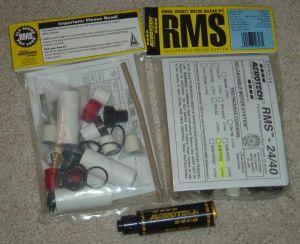| Construction Rating: | starstarstarstarstar_border |
| Flight Rating: | starstarstarstarstar |
| Overall Rating: | starstarstarstarstar |
| Manufacturer: | Aerotech  |
 Brief:
Brief:
The RMS case is real handy for sending small rockets high or just buying cheap motors for your bigger rockets. The case itself cost $40 but you do get to buy those less expensive reloads, which you start saving money after about 9 flights.
Construction:
The components to this motor are the casing, two end closures, and a tube of grease.
The instructions in the kit are easy to follow once you get the hang of it. I had trouble loading my first reload the liner because it didn't fit right.
Make sure you don't get grease on the delay element or your ejection charge won't fire. Once you run out of the grease it came with, you can you Vaseline instead. I always load mine at home the day before so I don't screw it up (like getting crud on an O-ring or forgetting a part at the launch), but if you choose to do that, don't put the ejection charge on until time for the launch. Overall, the construction is easy and sometimes fun. I just wish I took less time to load a motor.
Construction Rating: 4 out of 5
Flight:
At flight time I get tensed up because I know it could be a CATO and I would look like an idiot.
3....2....1.... launch. OH NO! Flames were coming out of the top of the rocket and catching it on fire. For the next 2 flights, it was worse! It was catching the fields on fire.
I figured out what I was doing wrong for those flights and since then I haven't had a CATO from a reload.
Motors used in it so far: Four E11s (1 CATOed), two F24s (both CATOed), six E28s, and three E18s.
Recovery:
When I looked at the case after the last CATO, I realized I needed to buy a new forward closure. It takes a beating when the propellant is burning out the top end! After those three CATOs I haven't had one since and all of them were my fault.
Flight Rating: 5 out of 5
Summary:
Everyone has a CATO sometimes and its usually their fault. I recommend this product to everyone who wants cheaper motors like me.
A lot of people treat me like a little kid at launches because I'm 11 but they don't understand I'm advanced in rocketry. This is a very good Aerotech product and you can use it in just about any Mid-Powered rocket.
Overall Rating: 5 out of 5
Other Reviews
- Aerotech 24mm RMS Motor By Kris Henderson
Aerotech's Reloadable Motor System (RMS) 24/40 motor kit. Allows for use with Aerotech motor reload kits, which in the long run saves you cash over using single use motors. Get the same high performance flights at about half the price of single use motors. The motor casing consists of one motor tube with a forward and an aft closure. The kit without the reloads consist of three metal pieces ...
 |
 |
R.L.P (June 24, 2005)
EMRR (June 27, 2005)
J.W.C. (June 27, 2005)
R.C.B. (August 31, 2005)
L.P. (October 2, 2005)
S.E.K. (December 30, 2006)
D.A.S. (May 5, 2010)
A.C.C. (May 29, 2010)
Mason Hazzard (August 7, 2011)
Im sorry to hear about all of the bad flights. Ive flown the 24mm casing plenty of times, and havent had a problem yet. All of my motors lit on the first try, and the delay seemed spot on. The only motor I have heard bad things about has been the E18. Aparently the Aft Closure continously blows out and the case is ruined, but other than that, Im happy. Just remember that most of the problems are probably operator error. If you get grease on the delay element, it either wont burn or will burn very slowly, and having the O rings in the wrong spot is just another thing that can cause a CATO.
 |
 |
C.S. (June 23, 2005)